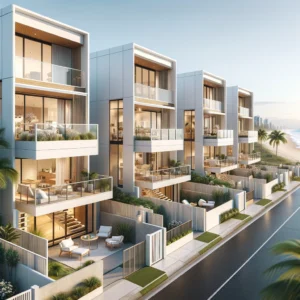It’s the great Australian dream – building a brand-new home for your family! Having the opportunity to design a home that perfectly suits your style and needs, customising it exactly the way you want, can be one of the most exciting things you’ll ever do.
But… It can be a very risky (and expensive!) game if you don’t get it right!
Building a new home is far more complex than just buying an existing house. When you buy a property with a house already on it, you negotiate a price with the agent, get your finance approved, settle then move in. It’s a very linear process and you know exactly what you’re spending (within your budget of course!).
Building new, on the other hand, brings in a number of additional steps, which all need to be worked through carefully. Getting anything wrong can result in your dream home becoming a nightmare, leading to significant delays and can be very costly.
To make things a bit easier for you, based upon our professional experience – as well as the personal experience of some of us within STAC having built their own homes (one of whom is right in the middle of one at the time of writing this!) – here are some tips on how you can navigate this exciting time of your life a bit more safely.
Before anything – Talk to your Finance Broker
Sorry to come in with the “talk to us” so early in the tips, but you genuinely need to have this conversation before anything – after all, there’s no point running around getting yourself excited about a block of land and your dream home design, only to find out that your maximum budget is miles off.
Discuss your objectives with your finance broker, they’ll assess your financial position, and what amount and type of funding you’ll potentially be able to access, so you can work out what budget you have for land and building.
Location Location Location
Putting in all this effort to build a new home, you want to make sure this is where you want to live for years to come. What suburbs do you like (and can afford!) – and keep in mind that there are always pockets within suburbs that are better or worse. How long will it take you to get to work? Where will the kids go to school? What amenities and services are nearby?
Vacant land is in short supply in many locations, so you may need to pay a premium for vacant land. If you’re looking at a “knockdown”, you’ll need to factor in the additional costs of demolition – and make sure you can actually do that (e.g. pre-1946 homes in Brisbane can be near impossible to demolish, and more expensive to renovate than a new build). If it’s a new housing estate development, get an idea of when land is registered and what covenants may apply.
Talk to multiple builders and be realistic about price
Talk to a number of home builders and get an idea of what type of houses they build – some only do “project homes”, some only do custom builds. Get some ballpark figures on what cost you may be looking at – and if you have a budget, make sure to keep some buffer versus what the builders tell you. Remember – the advertised house price is almost always a “base price”, kind of like when you buy a car with a sticker price of $50,000 that quickly ends up at $70,000 after you tick some boxes. The final price of the home can easily end up SIGNIFICANTLY higher after you choose certain flooring, appliances, tap-wear, curtains, air-conditioning etc. Then there are other costs such as site preparation (sloping blocks can cost a hell of a lot to retain) and landscaping.
It’s not uncommon for the total build price to end up being 20 to 30% higher than the “sticker price” advertised by the builder.
Put a contract on your land
Make an offer – within your budget of course! If your offer is accepted by the vendor (or land developer), it’s time to get finance approved. Even though you may not have a building contract in place yet, many banks will want to know what your construction budget is so that they can make sure that you will be able to afford the entire debt in due course – after all, no point in buying the land if you can’t afford to build the home!
Approved & Settled – congratulations, you’re now the owner of a block of land! Now, this is where things can get a bit complicated…
Choose your builder and start the plans!
Now be prepared for what can be a drawn-out process of designing your plans, choosing specifications, tendering for a price. Often this goes around and around a few times – most people tick so many boxes because they want the dream home, to then realise that’s going to blow the budget way beyond their limit. Consider any additional items you want to be built as a part of the total build, such as solar panels, swimming pools and other larger items. Unfortunately, this can be a very time consuming and frustrating process, in which you need to balance out your dreams with what reality needs to be.
Throughout this stage, keep in mind you’ll have to pay a range of costs, as well as a deposit (usually 5%) out of your own pocket. It is very important you factor these costs into your budgeting – so make sure the builder clearly spells these out for you.
The Construction Loan
Once you have a set of plans and total build cost, along with a fixed-price build contract, hand these over to your finance broker so that they can submit the application to the bank for a construction loan. They will order a valuation to make sure that you’re not over-capitalising – i.e. land plus build costs should not be more than what it’s worth when it’s finished); should the valuation come in lower than the total cost, you either need to pull back a bit on your costs, or you will be expected to contribute the difference between the valuation and total cost as additional equity. Construction loan approval – equity contribution confirmed – then…
Building your home!
Well, after the council has approved the plans. And you have contributed whatever amount of cash equity required. THEN the builder can start. As they work through construction, the builder will submit invoices for the bank to pay based upon the progress payments listed in your build contract. During this part of your journey, the construction loan will usually interest only; the land loan may be interest-only or principal & interest, depending on what your broker has negotiated. Keep that in mind, since you’ll also be paying a mortgage or rent somewhere else during the build – so your cash flow might be tight for 7 to 12 months!
What have we missed?
There are so many elements that go into building a house, that we’ve unfortunately had to leave out a fair bit in this short article, in order to avoid it becoming a novel. Soil issues, building contract negotiations, council restrictions, insurances, timeframe risks, even the risk of builders going broke…
Building a new home is never easy, and it rarely goes perfectly to plan or schedule, but if you go in prepared and armed with the right information, you’ll be in a much better position to achieve a better outcome.
If you’d like to learn more about building new, get in touch with our expert home finance team today.
- Your full financial needs and requirements need to be assessed prior to any offer or acceptance of a loan product.
- STAC Home Finance Pty Ltd (534124) is authorised under Australian Credit Licence 389328.
- Click here to read our Privacy Policy.



